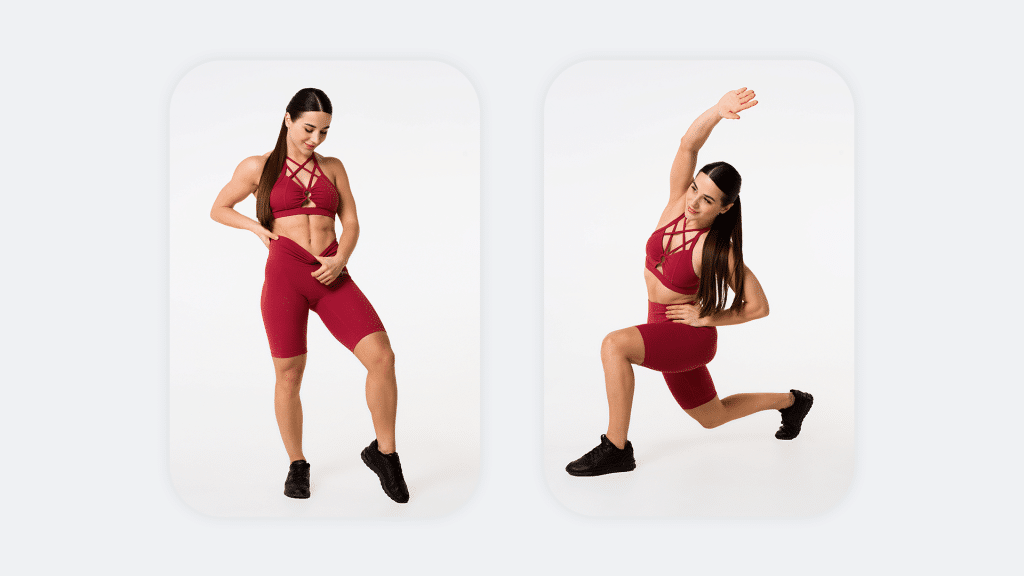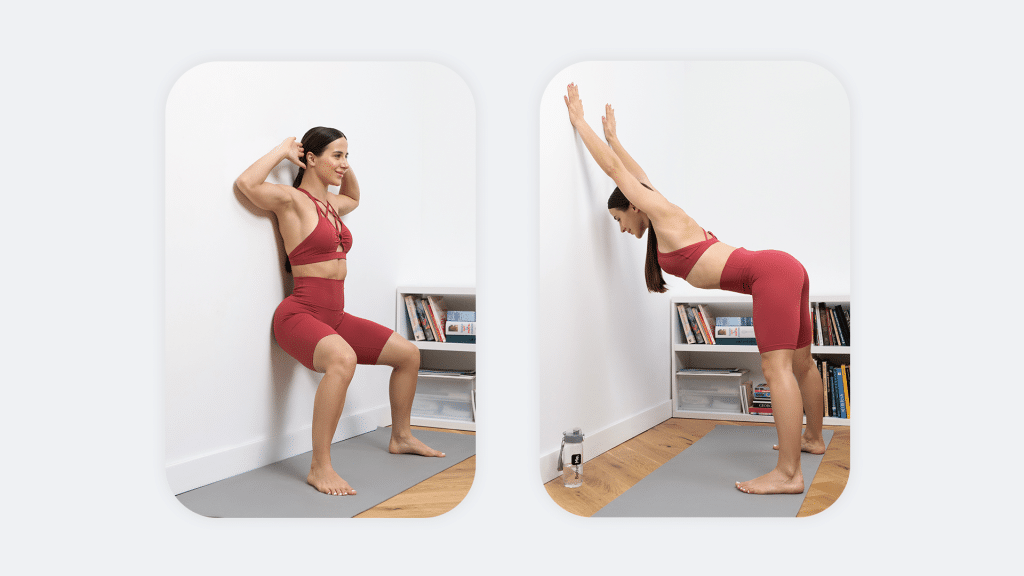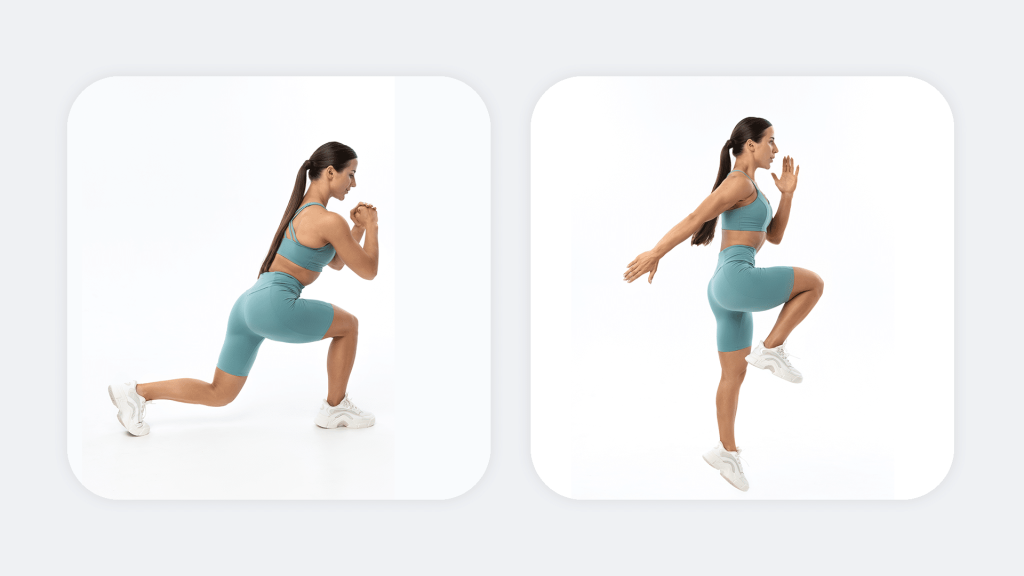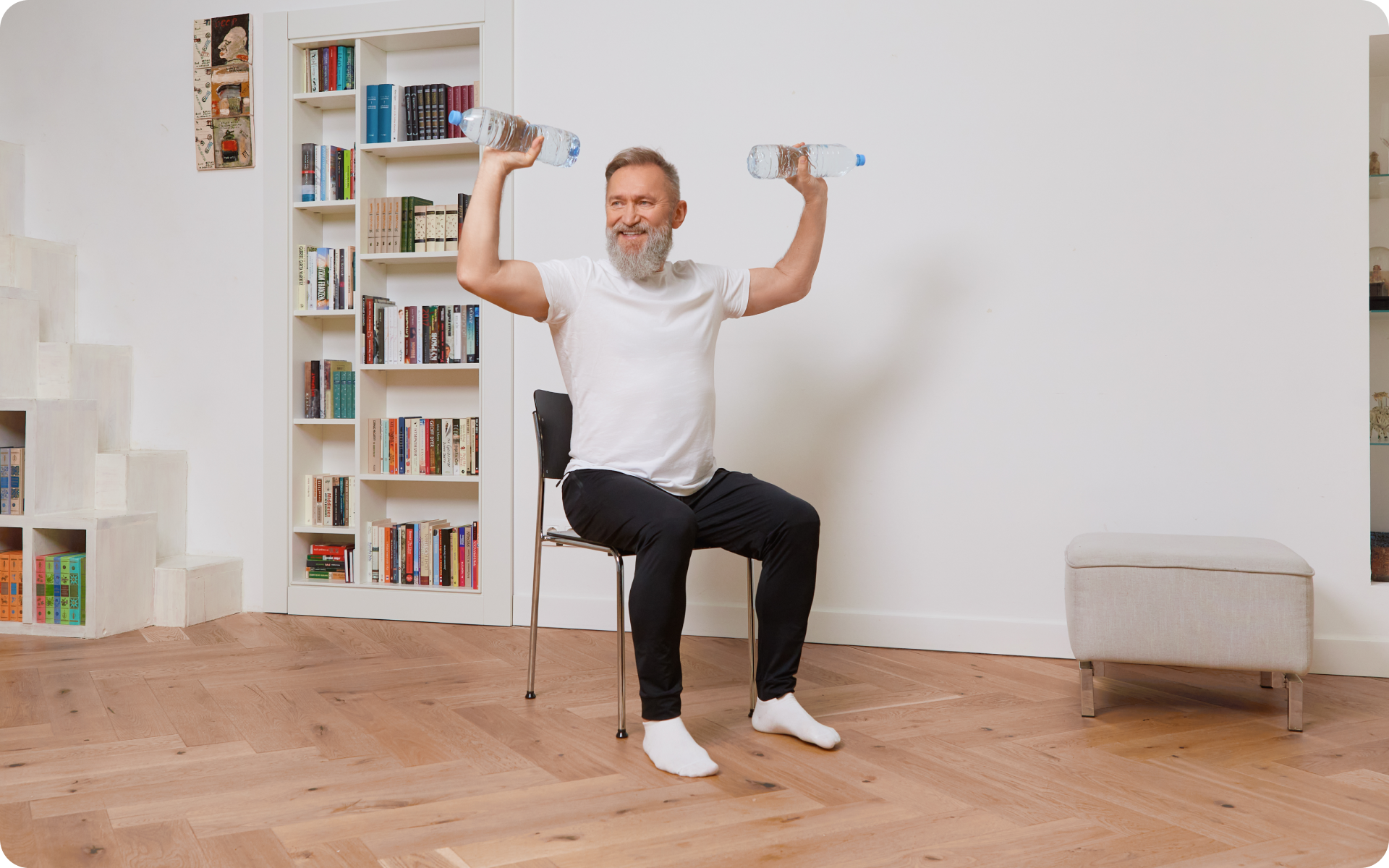Did you know that prolonged sitting can have a detrimental effect on your lower back health? In fact, studies show that people who sit for more than eight hours a day with no physical activity have the risk of dying similar to that by obesity and smoking. Worry not! With the right approach, you can transform your workspace into a healthier environment for your back. In this comprehensive guide we will introduce you to 10 chair exercises specifically designed to alleviate and prevent lower back pain. These exercises are not only easy to perform but also highly effective for improving back strength and overall spinal health. By incorporating these simple exercises into your daily routine, you can take a proactive step towards better back health and a more comfortable working experience.
What Are Chair Exercises For Lower Back Pain?
Chair exercises for lower back pain are a series of low-impact movements and stretches designed to be performed on a chair. These exercises focus on strengthening the muscles surrounding the spine, improving flexibility, and promoting proper posture – all of which contribute to a healthier and more comfortable lower back.
The mechanics of these exercises involve engaging various muscle groups in the lower back, hips, and core. By targeting these areas, chair exercises help stabilize the spine and reduce the strain on the lumbar region.
This is particularly important for people who sit long hours, as prolonged inactivity can lead to muscle imbalances and stiffness, further exacerbating lower back discomfort.
Chair exercises are effective because they address the common causes of lower back pain, such as weak muscles, poor posture, and limited range of motion. By working on these factors, these exercises can alleviate existing discomfort and help prevent future episodes of lower back pain.
Some of the key muscle groups targeted by chair exercises include:
1. Erector Spinae
These muscles run along the length of the spine and play a crucial role in maintaining an upright posture. Strengthening the erector spinae helps support the spine and reduces the risk of injury (4).
Read More: Chair Yoga For Core Strength: The Ultimate Guide
2. Core Muscles
The core muscles, which include the abdominals, obliques, and lower back muscles, are essential for stabilizing the spine and maintaining proper alignment. Strong core muscles can significantly reduce the likelihood of developing lower back pain (6).
3. Hip Flexors And Glutes
Tight hip flexors and weak gluteal muscles can contribute to lower back pain by causing an imbalance in the pelvis. Chair exercises that target these muscles can help restore balance and alleviate discomfort (5).
4. Hamstrings And Quadriceps
The muscles in the thighs also play a role in supporting the spine. Stretching and strengthening these muscles can help improve overall spinal health and alleviate lower back pain.
How Do You Fix Lower Back Pain From A Chair?
Lower back pain while sitting can be attributed to several factors, including:
1. Poor Posture
Slouching or maintaining an improper posture while sitting can put excessive strain on the spine, leading to discomfort and pain in the lower back (1).
2. Prolonged Inactivity
Sitting for extended periods without regular movement can cause muscle stiffness and imbalances, contributing to lower back pain (2).
3. Inadequate Lumbar Support
A chair that does not provide proper lumbar support can lead to increased pressure on the lower back, resulting in pain (3).
Whether you’re looking to simply pep up your fitness routine, jazz up your diet with mouth-watering low-calorie recipes or want to get your act together and significantly drop that number on your scale – BetterMe app has got you covered! Improve your body and revamp your life with us!
4. Weak Core Muscles
Insufficient core strength can result in a lack of spinal stability, causing the lower back to bear additional strain (6).
Chair exercises can be the first port of call for treating lower back pain. By targeting weak areas, stretching tight muscles, and improving posture, these exercises can help alleviate discomfort and prevent further recurrences of the condition.
To get started, try incorporating these 10 chair exercises for lower back pain into your daily routine:
Here are 10 chair exercises specifically designed to target lower back pain. Each exercise includes information on the targeted muscles, how it helps relieve pain, and step-by-step instructions.
1. Seated Cat-Cow Stretch
- Targeted Muscles: Erector spinae, abdominals, and pelvic muscles
- Pain Relief: Increases flexibility in the spine and relieves tension in the lower back
Instructions:
- Sit on the edge of a chair with your feet flat on the floor.
- Place your hands on your knees.
- Inhale and arch your back, lifting your chest and looking up towards the ceiling (Cow pose).
- Exhale and round your back, tucking your chin to your chest (Cat pose).
- Repeat for 5-10 cycles, moving slowly and smoothly between the two poses.
2. Seated Twist
- Targeted Muscles: Erector spinae, obliques, and transverse abdominis
- Pain Relief: Improves spinal mobility and releases tension in the lower back
Instructions:
- Sit up straight in a chair with your feet flat on the floor.
- Place your left hand on your right knee and your right hand on the backrest.
- Inhale and lengthen your spine.
- Exhale and gently twist to the right, keeping your hips facing forward.
- Hold the twist for 3-5 breaths, then return to center and repeat on the other side.
Read More: Advanced Chair Yoga Poses: Elevate Your Strength
3. Seated Hamstring Stretch
- Targeted Muscles: Hamstrings and lower back muscles
- Pain Relief: Lengthens tight hamstrings and reduces pressure on the lower back
Instructions:
- Sit on the edge of a chair with your right leg extended and your left foot flat on the floor.
- Flex your right foot, with your toes pointing up.
- Straighten your back and hinge forward from your hips, keeping your chest lifted.
- Reach for your right ankle or shin, depending on your flexibility.
- Hold the stretch for 15-30 seconds, then switch legs and repeat.
4. Seated Hip Flexor Stretch
- Targeted Muscles: Hip flexors, quadriceps, and lower back muscles
- Pain Relief: Reduces tightness in the hip flexors, which can contribute to lower back pain
Instructions:
- Sit on the edge of a chair with your feet flat on the floor.
- Slide your left foot back and lower your left knee towards the ground.
- Keep your right knee bent at a 90-degree angle, with your foot flat on the floor.
- Gently press your left hip forward to feel a stretch in the front of your left hip.
- Hold the stretch for 15-30 seconds, then switch sides and repeat.
5. Seated Figure-4 Stretch
- Targeted Muscles: Glutes, piriformis, and lower back muscles
- Pain Relief: Stretches tight gluteal muscles and relieves tension in the lower back
Instructions:
- Sit up straight in a chair with your feet flat on the floor.
- Cross your right ankle over your left knee, forming a figure-4 shape.
- Place your right hand on your right knee and gently press down.
- Maintain an upright posture and hinge forward from your hips.
- Hold the stretch for 15-30 seconds, then switch sides and repeat.
6. Seated Marches
- Targeted Muscles: Core muscles, hip flexors, and lower back muscles
- Pain Relief: Strengthens core stability and reduces strain on the lower back
Instructions:
- Sit up straight in a chair with your feet flat on the floor.
- Place your hands on your hips or hold onto the sides of the chair for support.
- Engage your core and slowly lift your right knee towards your chest.
- Lower your right foot back to the floor and repeat with your left knee.
- Continue alternating legs for 10-20 repetitions on each side.
If you struggle to even flirt with the idea of giving up your favorite foods or working out till your legs give way – BetterMe app is here to breathe a fresh perspective into the way you view the weight loss process! Check out the app and experience the fun side of fitness and dieting with BetterMe!
7. Seated Leg Extensions
- Targeted Muscles: Quadriceps and lower back muscles
- Pain Relief: Strengthens thigh muscles and supports proper spinal alignment
Instructions:
- Sit up straight in a chair with your feet flat on the floor.
- Hold onto the sides of the chair for support.
- Slowly extend your right leg until it is parallel to the floor, flexing your foot.
- Hold the leg extension for 2-3 seconds, then lower your foot back to the floor.
- Repeat for 10-15 repetitions, then switch legs and perform the same number of repetitions.
8. Seated Pelvic Tilts
- Targeted Muscles: Core muscles, pelvic muscles, and lower back muscles
- Pain Relief: Improves spinal alignment and strengthens supporting muscles
Instructions:
- Sit up straight in a chair with your feet flat on the floor.
- Place your hands on your hips.
- Engage your core and gently tilt your pelvis forward, creating a slight arch in your lower back.
- Reverse the motion by tilting your pelvis backward, rounding your lower back.
- Continue alternating between forward and backward tilts for 10-15 repetitions.
9. Seated Lower Back Press
- Targeted Muscles: Erector spinae and core muscles
- Pain Relief: Strengthens lower back muscles and improves posture
Instructions:
- Sit up straight in a chair with your feet flat on the floor.
- Place your hands behind your head, with your elbows out to the sides.
- Engage your core and press your lower back firmly into the chair’s backrest.
- Hold the press for 2-3 seconds, then release.
- Repeat for 10-15 repetitions.
10. Seated Lateral Bends
- Targeted Muscles: Obliques, erector spinae, and lower back muscles
- Pain Relief: Increases flexibility in the spine and reduces tension in the lower back
Instructions:
- Sit up straight in a chair with your feet flat on the floor.
- Place your left hand on your left hip and raise your right arm overhead.
- Inhale and lengthen your spine.
- Exhale and gently bend to the left, keeping your hips square and facing forward.
- Hold the bend for 2-3 breaths, then return to center and repeat on the other side.
What Are 3 Exercises To Avoid Lower Back Pain?
When dealing with lower back pain, it’s crucial to avoid exercises that may exacerbate the issue or hinder your recovery. In general, steer clear of activities that involve excessive twisting, heavy lifting, or sudden impact.
These types of movements can place undue stress on your spine and surrounding muscles, potentially worsening your pain or causing further injury. Here are three specific exercises to avoid when experiencing lower back pain:
1. Toe Touches (Standing Or Seated)
Toe touches require you to bend forward from the waist, which can place significant strain on your lower back muscles and spinal discs. This forward flexion movement compresses the front part of the vertebrae, leading to increased pressure on the intervertebral discs. As a result, if you have existing lower back issues, this exercise may exacerbate the problem.
2. Leg Presses
Leg presses involve pushing a weighted platform away from your body using your legs. This exercise can put considerable stress on your lower back, especially if performed with improper form.
During leg presses, your pelvis may tilt and your lower back may round, which can lead to increased pressure on your spinal discs. This is particularly risky if you already suffer from lower back pain or have a history of disc issues.
3. Sit-Ups And Traditional Crunches
Sit-ups and traditional crunches involve repeated flexion of the spine, which can contribute to lower back pain.
These exercises are stressful for the lumbar region, potentially causing or worsening existing discomfort. Moreover, they primarily target the hip flexors rather than the abdominal muscles, which can lead to muscle imbalances and further strain on the lower back.
How Should I Sit With Lower Back Pain?
Sitting with lower back pain can be uncomfortable, but by adopting the right posture and making a few adjustments, you can minimize discomfort. Here are some tips on how to sit with lower back pain:
1. Choose The Right Chair
Opt for an ergonomic chair with proper lumbar support that promotes a natural curve in your lower back. The chair should have adjustable features such as seat height, backrest angle, and armrests to accommodate your specific needs.
2. Maintain Proper Posture
Sit with your back firmly against the chair’s backrest, ensuring that your lower back is well-supported. Keep your feet flat on the floor, with your knees bent at a 90-degree angle and aligned with your hips. Your shoulders should be relaxed, and your head should be aligned over your shoulders.
3. Use Additional Support
If your chair does not provide adequate lumbar support, consider using a rolled-up towel or lumbar roll to maintain the natural curve of your lower back. Place the support between your lower back and the chair’s backrest.
4. Adjust Your Workspace
Position your computer monitor at eye level so you don’t have to tilt your head up or down to see it. Place your keyboard and mouse close to you to avoid reaching forward and straining your lower back.
5. Take Breaks
Stand up and move around every 30-60 minutes to relieve any pressure on your lower back. Incorporate gentle stretches during these breaks to help alleviate muscle stiffness.
6. Avoid Crossing Your Legs
Crossing your legs while sitting can lead to poor posture and exacerbate lower back pain. Instead, keep both feet flat on the floor with your knees facing forward.
7. Engage In Regular Exercise
Strengthening your core muscles and maintaining overall flexibility can help prevent and alleviate lower back pain. Incorporate regular exercise, including chair exercises, into your daily routine (6).
By following these guidelines, you can minimize discomfort while sitting with lower back pain and promote better spinal health.
Frequently Asked Questions
What Is The Best Chair For Lower Back Pain?
The best chair for lower back pain is an ergonomic chair that provides adequate lumbar support, promotes proper posture, and seat height, backrest angle, and armrests are adjustable features.
How To Exercise With Lower Back Pain?
When exercising with lower back pain, focus on low-impact activities that strengthen your core muscles, improve flexibility, and promote spinal stability without causing additional strain.
Examples include walking, swimming, yoga, and Pilates. Always consult with a healthcare professional before starting any new exercise program. This is especially true if you are recovering from an injury or have existing health concerns.
What Stretches Are Good For Lower Back Pain?
Some beneficial stretches for lower back pain include the cat-cow stretch, pelvic tilts, child’s pose, knees-to-chest stretch, and the seated figure-4 stretch. These stretches help to improve flexibility, reduce muscle tension, and alleviate discomfort in the lower back area.
What Exercises Cause Lower Back Pain?
Exercises that may cause or exacerbate lower back pain include toe touches, leg presses, sit-ups, and traditional crunches. These movements involve excessive twisting, heavy lifting, or sudden impact, which can place undue stress on the spine and surrounding muscles, potentially worsening your pain or causing further injury.
Conclusion
Managing lower back pain involves adopting a proper sitting posture, engaging in targeted chair exercises and stretches, and avoiding movements that can exacerbate the issue. By following these guidelines, you can effectively alleviate lower back discomfort and promote better spinal health.
DISCLAIMER:
This article is intended for general informational purposes only and does not serve to address individual circumstances. It is not a substitute for professional advice or help and should not be relied on for making any kind of decision-making. Any action taken as a direct or indirect result of the information in this article is entirely at your own risk and is your sole responsibility.
BetterMe, its content staff, and its medical advisors accept no responsibility for inaccuracies, errors, misstatements, inconsistencies, or omissions and specifically disclaim any liability, loss or risk, personal, professional or otherwise, which may be incurred as a consequence, directly or indirectly, of the use and/or application of any content.
You should always seek the advice of your physician or other qualified health provider with any questions you may have regarding a medical condition or your specific situation. Never disregard professional medical advice or delay seeking it because of BetterMe content. If you suspect or think you may have a medical emergency, call your doctor.
SOURCES:
- 3 surprising risks of poor posture (2021, harvard.edu)
- A Systematic Review of th e Effects of Exercise and Physical Activity on Non-Specific Chronic Low Back Pain (2016, nih.gov)
- Effectiveness of lumbar supports in low back functionality and disability in assembly-line workers (2019, nih.gov)
- Effect of Upper-Extremity Strengthening Exercises on the Lumbar Strength, Disability and Pain of Patients with Chronic Low Back Pain: A Randomized Controlled Study (2017, nih.gov)
- The Influence of Stretching the Hip Flexor Muscles on Performance Parameters. A Systematic Review with Meta-Analysis (2021, nih.gov)
- The real-world benefits of strengthening your core (2012, harvard.edu)














